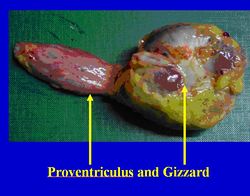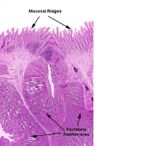Difference between revisions of "Proventriculus - Anatomy & Physiology"
Jump to navigation
Jump to search
| Line 41: | Line 41: | ||
[[Category:Avian Alimentary System - Anatomy & Physiology]] | [[Category:Avian Alimentary System - Anatomy & Physiology]] | ||
| − | [[Category:To Do - AimeeHicks | + | [[Category:To Do - AimeeHicks]] |
Revision as of 17:17, 17 December 2010
Introduction
The proventriculus is also referred to as the glandular stomach. It is connected by the isthmus to the gizzard.
Structure and Function
The proventriculus is a storage organ in fish and flesh eating birds. It is appropriate to a soft diet and secretes digestive enzymes. It contacts the left lobe of the liver ventrally and laterally. It is related dorso-caudally to the spleen. It is more cranial than the gizzard and lies to the left of the midline of the bird. It is spindle/fusiform shaped and is roughly 4cm long. The lumen diameter is similar to the oesophagus. There is no oesophageal sphincter.
Histology
- Mucous cells
- Columnar epithelium
- Basophilic
- Papillae- through which collecting ducts from glands run
- Lamina propria run into the papillae
- Hydrochloric acid and pepsin produced
- Glands in the submucosa
- Single tubular glands are grouped into lobules with a common opening into a papillae
- Serous membrane of mesothelial cells attached to the outer longitudinal layer of muscle
- 3 layers of lamina muscularis
- No parietal cells
Links
Test yourself with the Avian Alimentary Tract Flashcards

